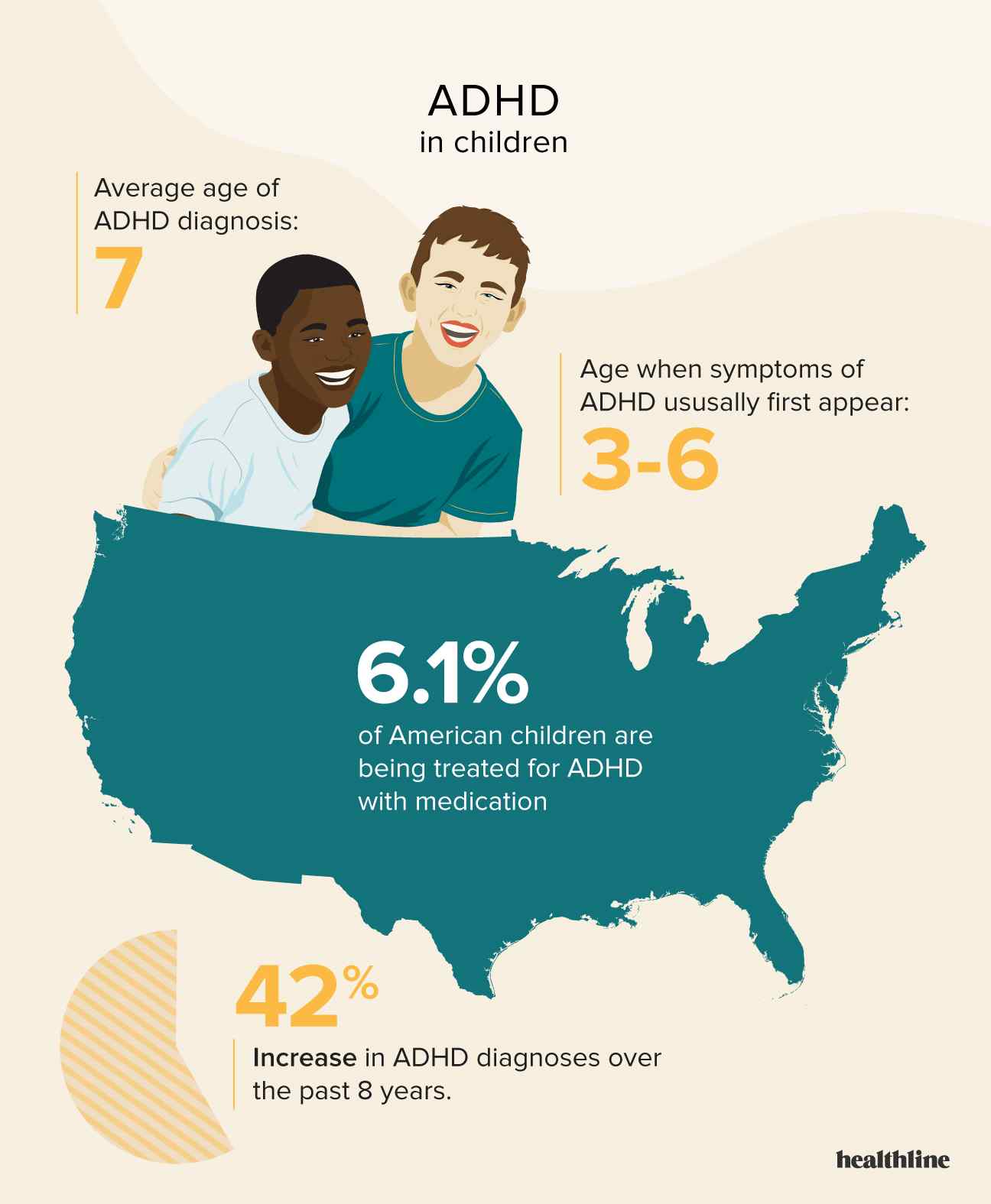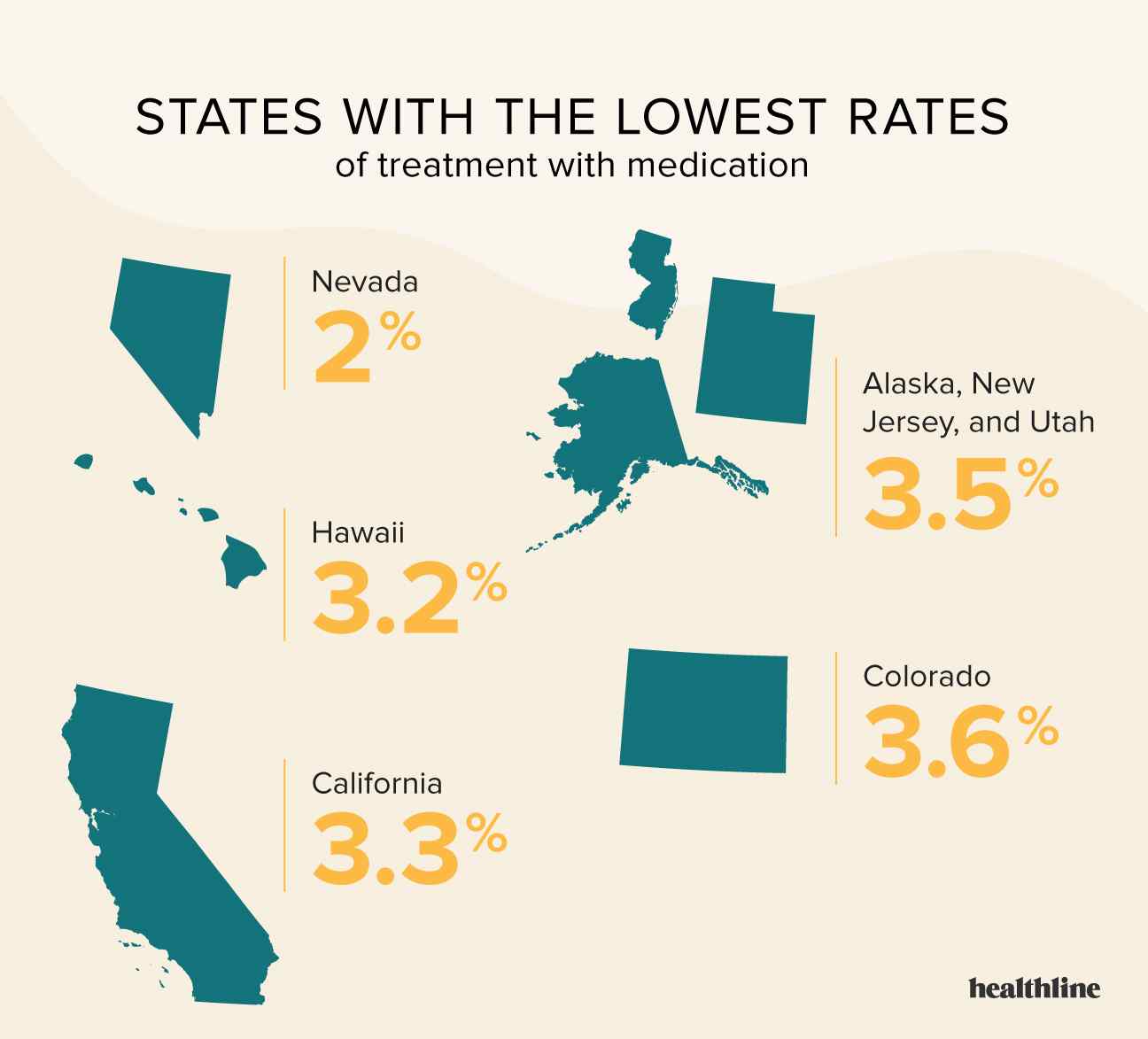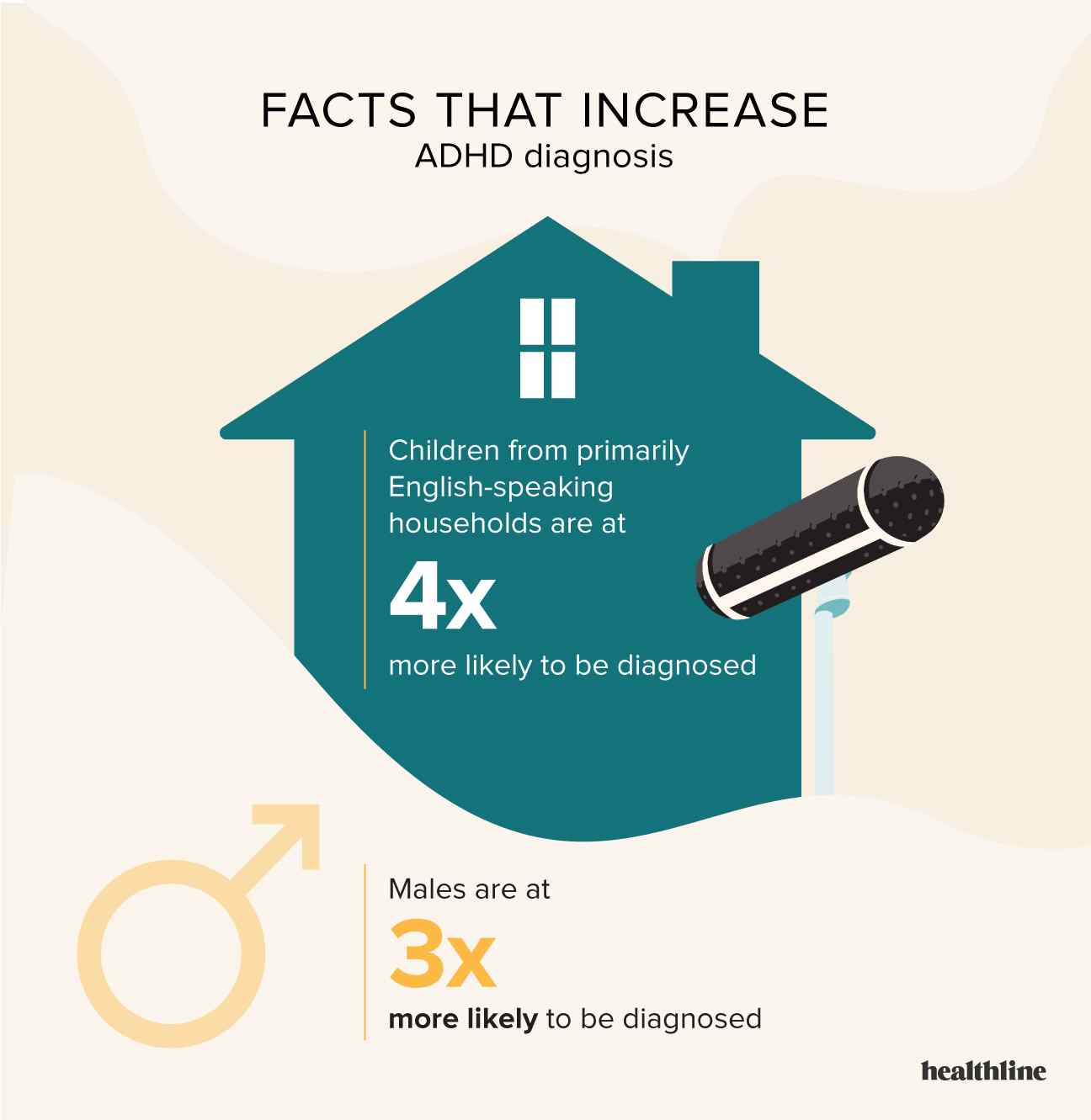45 ADHD Statistics: How Many People Have ADHD?
More than 9.4% of children (6.1 million) in the U.S. have an ADHD diagnosis, according to recent studies.

Key ADHD Statistics & Facts
- More than 9.4 percent of children (6.1 million) between ages 2 to 17 in the U.S. have an ADHD diagnosis.
- ADHD is more prevalent in children than adults, with about 9.4% of children having a current diagnosis compared to 4.4% of adults.
- Boys are more likely to be diagnosed with ADHD than girls.
- About 9 in 10 children with ADHD receive some kind of support or accommodation in school.
- About 10% of people with ADHD will develop a substance use disorder regarding alcohol or drugs.
- Bipolar disorder is about 6 times more common in adults with ADHD than adults without it.
- About 33% of students with ADHD dropout of high school, more than twice as many as those without ADHD.
- Only 15% of people with ADHD complete a four-year degree at a university.
- More than twice as many people with ADHD go to vocational or trade schools than their peers without ADHD.
- About 3 in 4 children diagnosed with ADHD receive medication, therapy, or a combination of the two.
- Drivers with ADHD have a risk of accidents that is about 47% higher than that of their non-ADHD peers.
- One study indicated that up to 20% of young children with an ADHD diagnosis might not actually have the condition.

Chapter 1: How Common Is ADHD?
Overall Prevalence & by Age Group
Prevalence by Gender
Prevalence by Race/Ethnicity

ADHD in Children
- About 9.4% of children aged 2 to 17 in the U.S. have received an ADD or ADHD diagnosis.
- There are 6.1 million U.S. children with an ADD or ADHD diagnosis.
- About 2.4% of diagnosed children are between the ages of 2 and 5 years old.
- About 9.6% of diagnosed children are between the ages of 6 and 11 years old.
- About 13.6% of diagnosed children are between the ages of 12 and 17 years old.
Boys are more likely to be diagnosed with ADHD than girls.
However, girls may have ADHD at a larger rate than previously known.
Girls are less likely to have hyperactive and aggressive symptoms, which means that their struggles might not be picked up on by parents or teachers.
ADHD is one of the most common developmental disorders that children are diagnosed with. Various global studies show different prevalence of ADHD in children, but worldwide the figure is around 5% of children.
ADHD in Teens
- About 8.7% of adolescents have been diagnosed with ADHD at some point in their lives.
- About 4.2% of teens have ADHD symptoms that severely impair them.
- ADHD was diagnosed 3 times as often in teenage boys as in teenage girls.
Teen girls are more likely to be diagnosed with ADHD when they begin to struggle in high school. Teen boys tend to show symptoms earlier.
Some girls are misdiagnosed with conditions like depression or anxiety, which is especially common since these disorders often accompany ADHD.
ADHD in Adults
- One study in 2016 showed that globally, about 2.8% of adults have ADHD. It is possible that that number is underreported due to a lack of diagnosis and awareness.
- In the U.S., studies indicate that about 4.4% of adults have ADHD.
- About 5.4% of men in the U.S. have diagnosed ADHD, while 3.2% of women in the U.S. have the same.
- In the U.S., ADHD diagnoses are more prevalent in white people than in other ethnic groups.
- It is estimated that 8.1% of U.S. adults will experience ADHD symptoms at some point in their life, but this is often during childhood. Adults tend to have less severe ADHD symptoms compared to children.
Adults with ADHD tend to have less serious symptoms. However, the symptoms can still be debilitating.
Adults with ADHD are more likely to have issues with relationships, mood regulation, sleeping, higher education, and keeping a steady job.
In people with the inattentive subtype, adult ADHD often looks like forgetfulness. People might forget where they're driving, misplace their keys, or forget about food on the stove. They may have such a reputation for chronic forgetfulness that they don't realize anything is wrong with their brain.
ADHD in the Classroom
- 9 out of 10 children diagnosed with ADHD in the United States receive support and accommodations in school.
- 2 out of 5 children diagnosed with ADHD in the United States have social skills training, while another 31% are trained by their parents.
- About 1 in 5 American children are given cognitive behavioral therapy to help manage their ADHD symptoms.
- Around 45% of children with ADHD also have a learning disability of some kind.
There is significant classroom support for children with ADHD. In addition to special education classrooms, students can receive accommodations like extra test time, fidget spinners, extra time to stand up, and help from educators.
Learning disabilities are extremely common in students with ADHD. About half of all students with ADHD have a learning disability related to reading, writing, or math. There are accommodations to help with these as well, once they have been evaluated and diagnosed.
ADHD Rates by Country
- The global prevalence of ADHD is about 2.8%, with some countries citing much higher numbers than others.
- Iraq and Romania are tied for the lowest number of ADHD cases reported, with just 0.6% of the population being diagnosed.
- The highest prevalence of ADHD has been reported in France, with 7.3% of the total population being diagnosed.
- The U.S. cites numbers between 4.4% and 5.2% for the total population diagnosed.
- In Poland, just 0.8% of the population has an ADHD diagnosis, followed by Australia with just 1.1%.
ADHD Rates by Gender
- Men are diagnosed with ADHD about 4 times as often as women.
- Women are more likely to receive late diagnoses, so the prevalence of ADHD in American women is 3.2% to men's 5.4%.
- Women are more likely to have the inattentive ADHD subtype, which presents without hyperactivity symptoms.
- One study from 2019 shows that the percentage of men who have ever received an ADHD diagnosis is 11.7%, while the percentage for women is just 5.7%.
- Another 2019 study showed that the ratio of diagnosis of ADHD in men to women could range from 2 to 1 all the way to 10 to 1.
In the past, ADHD was much more frequently diagnosed in boys. Boys are more likely to express aggression and hyperactive behavior. But with an increased focus on the ways that symptoms present in girls, there has been a narrowing of the gap between the genders.
States With The Highest Rates Of ADHD

States With The Lowest Rates Of ADHD

ADHD Rates by Race & Ethnicity
- ADHD tends to be diagnosed more frequently in white children, but researchers are unsure whether that's a true prevalence or an issue with the diagnostic process.
- About 14.2% of white children will be diagnosed with ADHD by age 12.
- About 11.8% of Black children will be diagnosed with ADHD by age 12.
- Asian children have the lowest rate of diagnosis in the U.S., with about 6.1% being diagnosed by age 12.
In addition, white boys were much more likely to receive an ADHD diagnosis than white girls.
Researchers found that Asian children were less likely to receive an ADHD diagnosis at every stage of the evaluation process. However, Black and Latino children tend to have rates of ADHD that are more similar to their white peers.
There are concerns that ADHD might be overlooked in Black and Latino children because of stereotyping and outdated diagnostic criteria.
Factors That Increase ADHD Prevalence
Did you know that children from primarily English-speaking households are 4 times more likely to be diagnosed with ADHD. Also, men are 3x more likely to be diagnosed.

Chapter 2: ADHD & Co-Occurring Mental Health Conditions
- Over 2 out of every 3 individuals with ADHD have another co-occurring condition.
- About half of all children with ADHD have a learning disability like difficulty with reading, math, or handwriting.
- About 25% of children with ADHD also have an autism spectrum disorder.
- Tourette syndrome is prevalent in 10% of children with ADHD, and is likely to be diagnosed long before the ADHD is.
- Speech issues affect 10% of children with ADHD, covering everything from stuttering to problems with pronouncing words.
- Half of all children with ADHD will be diagnosed with Oppositional Defiant Disorder, and 25% will be diagnosed with a general behavioral disorder.
- About 20% of children with ADHD also have bipolar disorder, while about 10% also have depression.
- Half of people with ADHD have some kind of sleep disorder, such as insomnia, sleeping too much, and issues with circadian rhythm.
- Anxiety is present in about 20% of people with ADHD.
- About 10% of people with ADHD will develop a substance use disorder, often linked to self-medication and high rates of impulsivity.
Whether a person is dealing with childhood or adult ADHD, it is common for there to be co-occurring conditions. In fact, many people receive a diagnosis of a different mental health condition or learning disability prior to being evaluated for ADHD.
Half of those with ADHD will be diagnosed with a sleep disorder or a learning disability.
Half of children with ADHD will be diagnosed with ODD, a disorder that causes children to rebel against authority.
Anxiety and depression are also extremely common in children with ADHD, showing up 5 to 10 times more often than in children who don't have an ADHD diagnosis.
Chapter 3: ADHD Dropout Rate
- An analysis of data in the United States shows that about 1 out of every 3 students with hyperactive ADHD will drop out of their high school.
- Teens without any psychiatric issues have a general dropout rate of about 15%, less than half that of those with ADHD.
- People with ADHD are less likely to pursue higher education, with statistics showing that anywhere from 2% to 8% of college students have the disorder.
- People with ADHD have a likelihood 11 times higher of not pursuing higher education than of going to a four-year college.
- About 50% of people with ADHD go to vocational schools, while only 18% of the population without ADHD does the same.
- Only 15% of people with ADHD will complete a four-year degree, while 48% of people without ADHD will.
Chapter 4: ADHD Driving Statistics
- A study from 2014 showed that adults with ADHD had an increased risk of up to 47% for having accidents when driving.
- About 37% of teenagers with ADHD receive a traffic violation in their first year of driving, while only 25% of non-ADHD teens do.
- More than 1 in 4 ADHD teens receive a moving violation when driving in their first year behind the wheel, while only 18% of non-ADHD teens do.
- ADHD drivers are more likely to drive while distracted, particularly when they are bored behind the wheel.
Driving can be more dangerous for people with ADHD because of a combination of factors. Executive dysfunction can make it difficult to keep track of everything happening around you. It's also easy to become distracted even without your phone.
For people with low impulse control, it's common to use a phone while driving if bored. Because of this, experts recommend that drivers with ADHD turn their phones off entirely and put them out of reach. The same goes for handheld devices like MP3 players.
Chapter 5: ADHD and Addiction Statistics
- People with ADHD are more likely to develop substance use disorders regarding alcohol or drugs.
- In alcoholics, the rate of ADHD is up to 10 times higher than the ADHD rate among the general population.
- ADHD is diagnosed in 1 out of every 4 adults undergoing treatment for substance use.
- About 14% of teenagers will develop problems with their alcohol consumption before they even reach the legal drinking age.
- About 40% of 15-year-olds with ADHD have experimented with alcohol, while only 22% of 15-year-olds without ADHD have.
- Young adults with and without ADHD consume alcohol at the same rate, but those with ADHD are significantly more likely to binge drink and develop a dependence.
Chapter 6: ADHD Diagnosis Rates
- About 1 out of 3 children diagnosed with ADHD will grow out of their symptoms as an adult, though some studies show that the number might be closer to 50%.
- About 9.4% of children receive an ADHD diagnosis at some point during their childhood, but they don't always have symptoms forever.
- Girls are much less likely to be diagnosed with ADHD than boys, but experts believe that they may be underdiagnosed.
Chapter 7: ADHD Comorbidity Statistics
- People with ADHD are very likely to have a comorbid mental health disorder, substance use disorder, or other condition.
- Nearly half of all children with ADHD also have a learning disability, while only 5% of those without ADHD do.
- More than 1 in 4 children with ADHD have behavioral problems, while only 2% of those without ADHD do.
- Anxiety and depression are some of the most common co-occurring disorders, occurring in 18% and 15% of children with ADHD respectively.
- Boys who have ADHD are at a 65% risk of writing disabilities, and girls who have ADHD are at a 57% risk.
- One study indicates that heart disease and ADHD might be linked, with 2% of children with ADHD also having a heart condition, compared to just 1.2% of children without ADHD.
- Nearly 1 out of every 5 adults with ADHD has bipolar disorder.
- 47% of adults with ADHD have an anxiety disorder like PTSD, agoraphobia, or social anxiety.
- About 15.2% of adults with ADHD have a substance use disorder, with 4.4% being dependent on drugs.
Chapter 8: ADHD Misdiagnosis Statistics
- ADHD is among the most frequently diagnosed conditions in children, leading to concerns about misdiagnosis.
- One study showed that up to 1 in 5 children with an ADHD diagnosis might not actually have ADHD.
- Younger children in a grade have a higher chance of being diagnosed with ADHD than older children, especially in kindergarten and first grade.
- Women who actually have ADHD are more likely to be misdiagnosed with depression or anxiety, particularly if they present without hyperactivity symptoms.
Chapter 9: Causes of ADHD
- The precise cause of ADHD is not known, but researchers have identified risk factors that increase a person's chances of being diagnosed.
- Genetics appear to play the largest overall role in ADHD. If someone in your immediate family has ADHD, there is a higher likelihood that you will develop it.
- ADHD may develop in people who have brain injuries, a low birth rate, or who are prematurely born.
- ADHD is also more likely to develop in people who are exposed to environmental toxins, alcohol, or tobacco while in the womb.
There are common misconceptions that ADHD is caused by video games, television, poor parenting, and eating sugar. But none of these things have been shown to have a significant effect on the development of ADHD. Sugar also doesn't increase hyperactivity in children in general.
With that said, these factors can make the symptoms of ADHD worse. Similarly, familial chaos can make ADHD symptoms worse. It is important for people with ADHD to have a calm, organized environment so they can thrive.
Chapter 10: Statistics on ADHD Treatment
- Around 77% of children who have a current ADHD diagnosis receive treatment of some kind, or about 3 in every 4 children.
- About 62% of children with ADHD take medication for the condition, with the highest percentage being 69% in the 6 to 11 year old demographic.
- About 47% of children with ADHD are given behavioral treatment, including more than half of 6 to 11 year olds and 60% of 2 to 5 year olds.
- Around 3 in 10 children with ADHD only take medication, without any behavioral or psychotherapy.
- Around 15% of children with ADHD only receive behavioral therapy without taking any medication.
- About 32% of children with ADHD are given both behavioral therapy and medication, or about 1 in 3 people.
- Nearly 1 in 4 children with ADHD are not treated for the condition with therapy or medication.
Chapter 11: What Is ADHD?
- ADHD is a disorder that is characterized by difficulty concentrating, easy distraction, poor mood regulation, low impulse control, and problems with executive function.
- ADHD is most common in children, but it can occur in adults as well.
- Anywhere from 50% to two-thirds of children with ADHD will continue to have symptoms throughout their adult lives.
- ADHD is among the most commonly diagnosed disorders in children, but it is not diagnosed enough in girls.
- ADHD is often debilitating, particularly for children trying to thrive in a traditional classroom environment.
- People with ADHD are at an increased risk of having other mental health issues, including substance abuse problems.
- People with ADHD often have problems with controlling their emotions and maintaining stable relationships, especially if they have certain comorbid disorders.
Conclusion
While ADHD has a reputation as a childhood illness, many adults suffer from it as well. We hope you've learned more about the prevalence of ADHD in your community!
Sources

Have Any Questions?
Whether you're curious about our services or need support, we're just a click away. Reach out or check our FAQs for quick answers.

